The European union has made a new rule called Directive on Administrative Cooperation (DAC8) to enhance tax transparency in the European Union.. In addition, this rule is a big step to make tax rules clearer and follow them better. Moreover, DAC8 says that people who work with cryptocurrencies must tell the government about their transactions. Additionally, it also changes the rules from DAC2 and DAC6 a lot. Consequently, this new rule has big effects on cryptocurrency and rich people. Therefore, it brings problems that need solving. Finally, to follow this rule, you need a plan that shows all the steps you must take.
Core Objectives and Scope of DAC8
- DAC8 aims to enhance tax transparency in the European Union, especially in the evolving cryptocurrency sector, by mandating robust reporting mechanisms for accurate tax compliance.
- DAC8 works together with existing rules like DAC2 (Common Reporting Standard – CRS) and DAC6, making the regulations broader and clearer.
- DAC8 has extraterritorial reach, imposing obligations on both EU-based and non-EU Crypto-Asset Service Providers (CASPs) and Crypto Asset Operators.
Detailed Provisions of DAC8
- Crypto-Asset Reporting Framework:
- Scope of Reporting: CASPs and Crypto Asset Operators must report transactions involving crypto-assets, including exchanges and transfers.
- Client Onboarding: The rule requires extra careful checking when bringing in new clients, similar to CRS rules. It asks for self-certification forms and lots of information about the clients.
- Data Collection and Exchange: Information such as name, address, tax residency, TIN, and details of controlling persons must be collected and exchanged in line with CRS protocols.
- Blocking of Transactions: DAC8 mandates that CASPs must block transactions if they do not receive the necessary information within 60 days after issuing two reminders.
- Information Exchange and Reporting Timelines:
- Member states are required to exchange relevant information within nine months following the end of the calendar year to which the reporting pertains.
- The directive stipulates local reporting deadlines for CASPs.
- Inclusion of E-Money Institutions:
- DAC8 revises the definitions under CRS to include entities holding e-money or Central Bank Digital Currencies (CBDCs) within the CRS framework.
- Specific exemptions are provided for smaller accounts holding Electronic Money Products.
Additional Reporting Requirements Under CRS
- Comprehensive Reporting Data: DAC8 introduces new fields in CRS reporting, including account type (Pre-existing/New), joint account details, and roles of Controlling Persons in entity account holders.
Tax Transparency for High-Net-Worth Individuals
- Advance Cross-Border Tax Rulings: DAC8 includes advanced cross-border tax rulings for high-net-worth individuals in information exchange, enhancing tax transparency in the European Union.
Legal Professional Privilege and Reporting
- DAC8 changes DAC6 to allow exceptions for reporting duties when legal professionals can keep information secret. Intermediaries must tell their clients about their reporting duties.
Implementation Challenges and Compliance Strategy
- Systems and Procedures Upgrade:
- Financial institutions must equip their systems to handle the new data elements and reporting requirements introduced by DAC8.
- This involves checking and changing how data is collected. In addition, it includes making sure it’s accurate and using easy tools for reporting.
- Data Collection and Verification:
- Institutions need to collect missing information/documentation promptly.
- Compliance officers need to carefully check self-certification forms. They should make sure the information matches the existing AML documents and follows CRS rules.
- Targeted Compliance and Audit Focus:
- Tax authorities should closely examine banks and other financial institutions. They should focus on situations where clients or investors don’t have enough paperwork, which suggests possible rule violations.
The approval of DAC8 marks an important step in the EU’s path to a clearer and obeying money environment. Additionally, this rule not only handles the intricacies of cryptocurrency deals but also makes the current tax reporting rules stronger. As a result, financial companies need to get ready for the adjustments as the date for putting it into action on 1 January 2026 gets closer. Consequently, they must make sure they follow the improved reporting and careful investigation needs. Overall, DAC8 is making progress for a more equal and understandable money setup, thereby getting the EU’s tax reporting rules in sync with the worldwide move toward clear digital finance.
FAQs on Enhancing Tax Transparency
Under DAC8, anyone dealing with cryptocurrencies has to report these transactions to the government. This means more checks and sharing of information to stop tax evasion.
They must report crypto transactions, check new clients carefully, and block transactions if they don’t get needed information on time. It’s all about being more open with tax info.
Yes, member states must share tax information within nine months after the year ends. Crypto service providers also have specific deadlines for reporting to local authorities.
Yes, DAC8 brings e-money institutions and digital currencies under its rules, meaning these entities also need to report certain transactions just like traditional financial institutions.
Financial institutions will need to update their systems to handle new reporting requirements and ensure they’re collecting and checking all the right information to stay compliant.
Tax transparency allows taxpayers to have a clearer understanding of their tax obligations, rights, and the overall tax system. It helps reduce uncertainty, confusion, and potential disputes related to tax matters.



